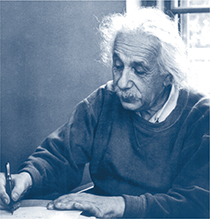Energy and Mass
Physicist Albert Einstein (1879—1955), shown in Figure 15, developed his special theory of relativity in 1905. This theory included the now-famous equation E = mc2. In Einstein's equation, E is energy, m is mass, and c is the speed of light. This seemingly ordinary equation has surprising consequences.  Einstein's equation, E = mc2, says that energy and mass are equivalent and can be converted into each other. In other words, energy is released as matter is destroyed, and matter can be created from energy.
Einstein's equation, E = mc2, says that energy and mass are equivalent and can be converted into each other. In other words, energy is released as matter is destroyed, and matter can be created from energy.
Notice that the speed of light is squared in Einstein's equation. The speed of light is an extremely large number, meters per second. Thus, a tiny amount of matter can produce an enormous amount of energy. Suppose 1 gram of matter were entirely converted into energy.
In comparison, 1 gram of TNT produces only 2931 joules of energy. In nuclear fission and fusion reactions, however, large amounts of energy are released by the destruction of very small amounts of matter. Therefore, the law of conservation of energy has been modified to say that mass and energy together are always conserved.
Figure 15 Albert Einstein made important contributions to many areas of physics. His theory of special relativity showed that energy and mass are equivalent.

Section 15.2 Assessment
Reviewing Concepts
 Describe how energy can be converted from one form to another in a wind-up toy.
Describe how energy can be converted from one form to another in a wind-up toy. What does the law of conservation of energy state?
What does the law of conservation of energy state? As an object falls in free fall, what energy change is taking place?
As an object falls in free fall, what energy change is taking place? What did Einstein conclude about the relationship between energy and mass?
What did Einstein conclude about the relationship between energy and mass?What type of energy change results when friction slows down an object?
Describe the energy of a playground swing at its highest position.
Critical Thinking
Inferring Why does a bouncing ball rise to a lower height with each bounce? What energy conversion is taking place?
Applying Concepts To begin a dive, a diver jumps into the air and then lands on the diving board, causing it to bend. What type of energy conversions occur as the board springs back and propels the diver up into the air?
Math Practice
A 0.15-kg ball is thrown into the air and rises to a height of 20.0 m. How much kinetic energy did the ball initially have?
A 125-g steel ball with a kinetic energy of 0.25 J rolls along a horizontal track. How high up an inclined track will the ball roll if friction can be ignored?




